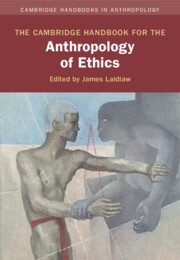Book contents
- The Cambridge Handbook for the Anthropology of Ethics
- Cambridge Handbooks in Anthropology
- The Cambridge Handbook for the Anthropology of Ethics
- Copyright page
- Contents
- Contributors
- 1 Introduction
- Part I Intellectual Sources and Disciplinary Engagements
- Part II Aspects of Ethical Agency
- 9 Making the Ethical in Social Interaction
- 10 Freedom
- 11 Responsibility
- 12 Emotion and Affect
- 13 Happiness and Well-Being
- 14 Suffering and Sympathy
- 15 Ambiguity and Difference
- Part III Media and Modes of Ethical Practice
- Part IV Intimate and Everyday Life
- Part V Institutional Life
- Index
- References
15 - Ambiguity and Difference
Notation, Ritual, and Shared Experience in Constructing Pluralism
from Part II - Aspects of Ethical Agency
Published online by Cambridge University Press: 11 May 2023
- The Cambridge Handbook for the Anthropology of Ethics
- Cambridge Handbooks in Anthropology
- The Cambridge Handbook for the Anthropology of Ethics
- Copyright page
- Contents
- Contributors
- 1 Introduction
- Part I Intellectual Sources and Disciplinary Engagements
- Part II Aspects of Ethical Agency
- 9 Making the Ethical in Social Interaction
- 10 Freedom
- 11 Responsibility
- 12 Emotion and Affect
- 13 Happiness and Well-Being
- 14 Suffering and Sympathy
- 15 Ambiguity and Difference
- Part III Media and Modes of Ethical Practice
- Part IV Intimate and Everyday Life
- Part V Institutional Life
- Index
- References
Summary
We cannot avoid the ambiguities that are inherent in the process of drawing social boundaries. This essay suggests thinking about the nature of those boundaries in three ways, to show how each can reframe our relationships. First, ‘notation’ is an attempt to conquer ambiguity by creating ever more categories and rules. This is the usual way we think about boundaries, but it also contains important limitations. Second, ‘ritual’ includes those acts that are formalized by social convention and repeated regularly. Ritual crosses boundaries of all kinds: between humans and spirits, men and women, food and people. Third, we can bracket away the categories of both notation and ritual by focussing on the full complexity and idiosyncrasy of a given moment, which we will call ‘shared experience’. On a temporary and ad hoc basis, this strategy lets us take practical action, eliding the problem of categories and the ambiguities they produce. These three analytic models are not mutually exclusive. Using ethnographic examples primarily from China, we argue that all three are necessary, but they intermix in different ways, and the nature of that mix contributes significantly to the local nature of pluralism.
- Type
- Chapter
- Information
- The Cambridge Handbook for the Anthropology of Ethics , pp. 389 - 408Publisher: Cambridge University PressPrint publication year: 2023



